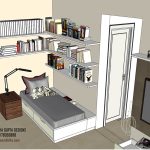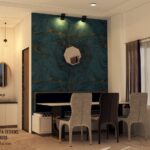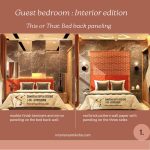Modern interior design is a dynamic and evolving field that seamlessly blends aesthetics, functionality, and innovation.
While this may not seem anything out of the ordinary or something new, it plays a very significant role in today’s interior world because the personal spaces are getting compact day by day with increasing population and an array of choices of materials and finishes in the market.
People are becoming more aware of the importance of hiring a professional for the interiors of their residential and office spaces. Hence, as a designer, it becomes more and more important for me to educate not just my fellow designers, but also my clients.
Achieving a contemporary look involves careful consideration of various elements, from space planning to material specifications and lighting.
In this article, we explore the key components that contribute to the creation of a modern interior space.
Let’s take a look at each element in detail one by one.
· Space Planning
One of the foundational elements of modern interior design is effective space planning.
This becomes particularly crucial when dealing with limited space and the challenge of accommodating specific furniture pieces.
For example, envision designing a 9′ x 10′ bedroom intended for use as a children’s room.
The task involves integrating a comfortable bunk bed, a wardrobe suitable for two children, and a study table with an additional overhead book cabinet.
Strategic placement and thoughtful arrangement of these elements are essential to maximize functionality without compromising on style.
Here’s how I planned this bedroom with the aforementioned requirements.
Of course, there can be more options for the furniture layout here. But, a lot of technical feasibilities (in terms of the location of switchboards in the room- which require minimal shifting or customization), Vastu compliance, for the position of the headboard in the room and study table direction were taken into account. And the final layout set up for the room was this-
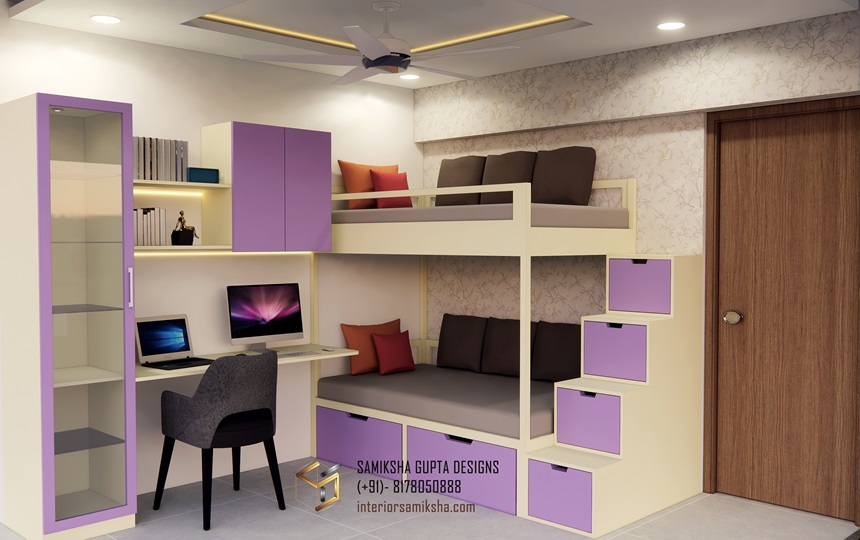
· Material Specifications
The choice of materials plays a pivotal role in defining the contemporary appeal of interior spaces. Different materials contribute to various styles, and it’s crucial to make judicious selections to achieve a modern aesthetic.
While some materials may possess aesthetic qualities, they may align more with rustic or traditional interior styles.
Therefore, designers need to carefully consider the materials used in furniture, flooring, and other elements to ensure a cohesive and contemporary look.
Here I have used plywood with a laminate finish.
I recommend using only BWR ply for the furniture of the house There should be no compromise on the standard quality of the core materials of furniture if you’re looking for durability and low maintenance.
Also, a laminate thickness of 1mm should be used, especially for the external application on furniture. Laminates thinner than this cause cracks and air bumps which spoil the furniture and look very shabby and tell poor workmanship.
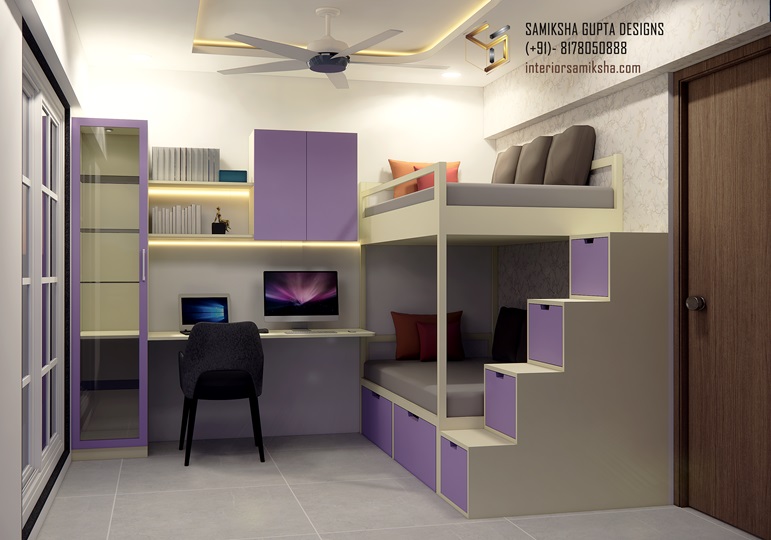
· Colour Theme
The proper selection of colours establishes the overarching theme of a space.
Modern interior design often embraces a minimalistic colour palette, focusing on neutral tones with occasional pops of vibrant colours.
The arrangement of colours on furniture can be strategically planned based on the utility of the space and personal preferences.
For instance, in a kids’ bedroom, a combination of purple and off-white can create a personalized and visually appealing environment, catering to the preferences of the children inhabiting the room.

For a bigger room, we can go with bolder colour choices. But, I highly recommend that listen to your interior designer especially in this stage as they know better. You may have a liking for a particular colour, but only they can guide you if that colour combination would suit your space or not.
· Lighting
Diverse colour temperatures play a pivotal role in shaping the ambience of a space.
The size of the space and its intended purpose are crucial factors when planning the lighting. Task lighting, best suited in white colour tones, offers a cool and focused illumination for specific activities.
Ambient lighting can vary within the neutral to warm spectrum, depending on the desired mood and overall atmosphere in the room.
Thoughtful consideration of these factors ensures a well-balanced and purposeful lighting arrangement, enhancing the overall modern appeal.
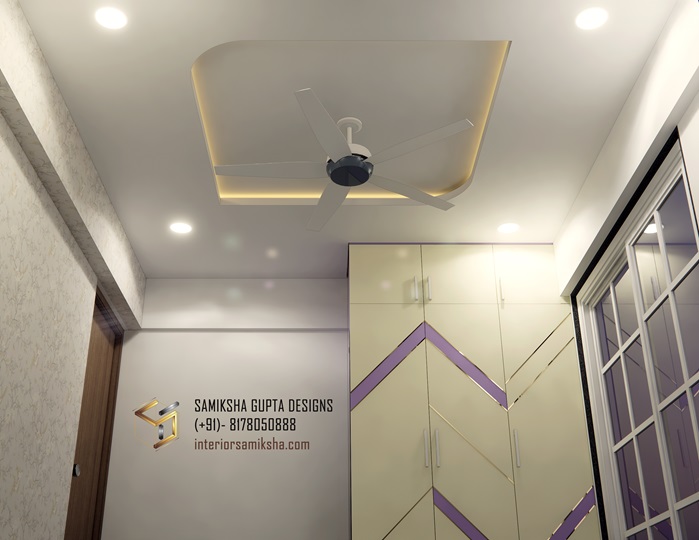
· Working Within the Budget
Designing within a budget is a common challenge, but it also presents an opportunity for creative and innovative solutions.
Limited financial resources encourage designers to think outside the box and explore cost-effective ideas.
I usually play around or experiment with different materials which are cheaper but give the same look as something more expensive. A lot of times clients come up with their likings and reference images from Pinterest or Google and ask to get the same output for their interior. It can get pretty tricky sometimes. But that’s the fun, right?
These days a lot of alternate options are available in the market that are cost effective, and yet cater to the desired result. You just need to explore a bit. I would suggest if you could manage a day, go with your designer to do a market visit and explore for yourself. It’s a fun process.
This challenge transforms the design process into an exciting and rewarding endeavour, pushing designers to find unique and resourceful solutions that align with the modern aesthetic.
Embracing budgetary constraints can lead to unexpected, yet stylish, outcomes.
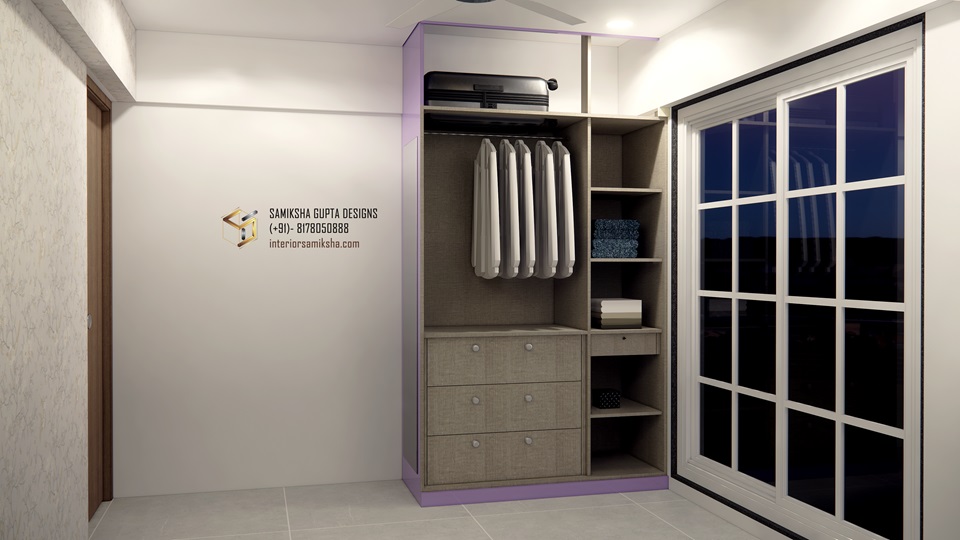
Conclusion
In conclusion, the key elements of modern interior design encompass
- effective space planning,
- thoughtful material specifications,
- a carefully chosen colour theme,
- and purposeful lighting.
Working within budgetary limitations adds an extra layer of creativity to the process, turning challenges into opportunities for innovation.
By embracing these elements, designers can create contemporary spaces that are not only visually appealing but also functional and reflective of the inhabitants’ personalities and preferences.
If you need professional advice or looking for design consultancy, feel free to drop me a message and I will get in touch with you ASAP.
The first consultancy call is free! 🙂

